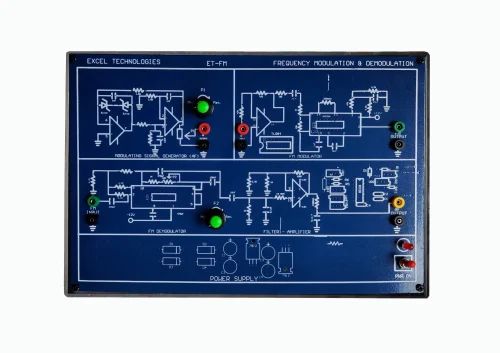Frequency Modulation
Frequency
Modulation
Experiment No:
Experiment Name: Study of Frequency Modulation
Objective:
To study and understand
the process of frequency modulation by observing the changes in the carrier
wave’s frequency in accordance with the message signal’s variations.
Theory:
Frequency Modulation (FM)
is a method of encoding information on a carrier wave by varying the
instantaneous frequency of the wave. In FM, the frequency deviation of the
carrier wave is proportional to the amplitude of the input signal (message
signal). This technique is widely used in radio broadcasting, telemetry, and
other forms of data communication because of its resilience to signal
degradation and noise.
s(t) = Ac cos(2πfct + 2πkf ∫T0 m(τ)dτ
where,
Ac is
the Amplitude of the Carrier Signal
fc is
the Frequency of the Carrier Signal
kf is
the Frequency Deviation Sensitivity
m(t) is
the Modulating Signal
Apparatus:
1.Signal generator.
2.Function generator.
3.Frequency Modulator
circuit or FM modulator kit.
4.Oscilloscope.
5.Connecting wires.
6.Breadboard or
modulation trainer kit.
Circuit Diagram:
Setup: Connect the signal
generator and function generator to the frequency modulator circuit as per the
circuit diagram.
Carrier Signal: Set the
signal generator to produce a sine wave with a frequency of around 1 MHz (the
carrier wave).
Message Signal: Set the
function generator to produce a lower frequency sine wave (1 kHz), which will
serve as the message signal.
Observation: Use the
oscilloscope to observe the carrier wave, the message signal, and the
frequency-modulated signal.
Connect one channel of
the oscilloscope to the carrier wave to ensure it’s correctly set.
Connect another channel
to the message signal to verify its frequency and amplitude.
Connect the output of the
modulator to the oscilloscope to observe the frequency-modulated signal.
Adjustments: Adjust the
amplitude of the message signal and observe how it affects the modulated
output. Notice the changes in the frequency of the carrier wave as the message
signal’s amplitude varies.
Recording Data: Capture
screenshots or drawings of the waveforms displayed on the oscilloscope for
analysis. If a spectrum analyzer is available, use it to observe the frequency
spectrum of the modulated signal.
Analysis: Compare the
frequency deviations observed with the theoretical expectations based on the
amplitude of the message signal.
Conclusion:
Through this experiment,
the principles of frequency modulation were successfully demonstrated. By
varying the amplitude of the message signal, corresponding changes in the
frequency of the carrier wave were observed, thereby confirming the theoretical
concepts of frequency modulation. The use of an oscilloscope was crucial in
visualizing these changes, allowing for a clear understanding of the modulation
process.




মন্তব্যসমূহ
একটি মন্তব্য পোস্ট করুন